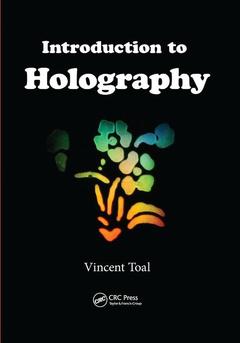Description
Introduction to Holography
Series in Optics and Optoelectronics Series
Author: Toal Vincent
Language: English
Subjects for Introduction to Holography:
Approximative price 72.36 €
In Print (Delivery period: 14 days).
Add to cartPublication date: 10-2019
· 17.8x25.4 cm · Paperback
Approximative price 184.47 €
In Print (Delivery period: 15 days).
Add to cartPublication date: 09-2011
472 p. · 17.8x25.4 cm · Hardback
Description
/li>Contents
/li>Readership
/li>Biography
/li>
Over the course of its 60-year history, holography has enabled new insights into the nature of light and has contributed to innovative applications, including many unrelated to optics. Introduction to Holography explains how to use holographic techniques to solve specific problems in a variety of fields. The text focuses on the state of development of existing and emerging holographic applications. Numerical problems are provided at the end of each chapter.
After a review of essential optics, the book presents basic holographic principles. It introduces the theory of thick holograms, along with a less demanding and more insightful path to important results based on the work of Jacques Ludman. Examining the use of holography in practice, the author then describes the conditions for successful holography in the laboratory, including various lasers commonly used for holography. He also discusses recording materials and their key holographic characteristics. The final portion of the book deals with applications of holography, including imaging, holographic interferometry, holographic optical elements, and data storage. The text also explores digital and computer-generated holography, light-in-flight and first-arriving light techniques and their applications, polarization holography, and holography for sensing applications.
Since its invention in 1948, holography has evolved into a mature technology with a wide range of applications. This practical guide to the field offers a comprehensive survey of contemporary holographic techniques and applications.
OPTICS
Light, Waves, and Rays
Introduction
Description of light waves
Spatial frequency
The equation of a plane wave
Nonplanar wavefronts
Geometrical optics
Reflection, refraction, and the Fresnel equations
Introduction to spatial filtering
Physical Optics
Introduction
Diffraction
Diffraction and spatial Fourier transformation
Phase effect of a thin lens
Fourier transformation by a lens
Fourier transform property of a lens—a physical argument
Interference by division of amplitude
Coherence
Polarized light
PRINCIPLES OF HOLOGRAPHY
Introducing Holography
Introduction: difference between two spatial frequencies
Recording and reconstruction of a simple diffraction grating
Generalized recording and reconstruction
A short history of holography
Simple theory of holography
Phase conjugacy
Phase holograms
Volume Holography
Introduction
Volume holography and coupled-wave theory
Characteristics of thick holographic gratings
Rigorous coupled-wave theory
A simpler approach
HOLOGRAPHY IN PRACTICE
Requirements for Holography
Introduction
Coherence
The Michelson interferometer
Lasers
The Fabry–Perot interferometer, etalon, and cavity
Stimulated emission and the optical amplifier
Laser systems
Q-switched lasers
Frequency doubled lasers
Mode locking of lasers
Spatial coherence of lasers
Laser safety
Mechanical stability
Thermal stability
Checking for stability
Resolution of the recording material
Recording Materials
Introduction
Silver halide
Dichromated gelatin (DCG)
Thermoplastics
Photoresists
Self-processing materials
Holographic sensitivity
Recording Materials in Practice
Introduction
Nonlinear effects
Grain noise
The speckle effect
Signal-to-noise ratio in holography
Experimental evaluation of holographic characteristics
Effects arising from dissimilarities between reference beams in recording and reconstruction
APPLICATIONS
Holographic Displays
Introduction
Single-beam holographic display
Split-beam holographic displays
Benton holograms
White light (Denisyuk) holograms
Wide field holography
Color holograms
Dynamic holographic displays
Very large format holographic displays
Quantum entanglement holography—imaging the inaccessible
Good practice in hologram recording
Other Imaging Applications
Introduction
Holographic imaging of three-dimensional spaces
Further applications of phase conjugation
Multiple imaging
Total internal reflection and evanescent wave holography
Evanescent waves in diffracted light
Mass copying of holograms
Holographic Interferometry
Introduction
Basic principle
Phase change due to object displacement
Fringe localization
Live fringe holographic interferometry
Frozen fringe holographic interferometry
Compensation for rigid body motion accompanying loading
Double pulse holographic interferometry
Holographic interferometry of vibrating objects
Stroboscopic methods
Holographic surface profilometry
Phase conjugate holographic interferometry
Fringe analysis
Speckle pattern interferometry
Holographic Optical Elements
Introduction
Diffraction gratings
Spectral filters
Lenses
Beam splitters and beam combiners
Scanners
Lighting control and solar concentrators
Multiplexing and demultiplexing
Optical interconnects
Holographic projection screens
Photonic bandgap devices
Holographic polymer-dispersed liquid crystal devices
Holographic Data Storage and Information Processing
Introduction
Holographic data storage capacity
Bit format and page format
Storage media
Multiplexing
Phase-coded data
Error avoidance
Exposure scheduling
Data and image processing
Optical logic
Holographic optical neural networks
Quantum holographic data storage
Digital Holography
Introduction
Spatial frequency bandwidth and sampling requirements
Recording and numerical reconstruction
Suppression of the zero-order and the twin image
Improving the resolution in digital holography
Digital holographic microscopy
Other applications of digital holography
Computer-Generated Holograms
Introduction
Methods of representation
Three-dimensional objects
Optical testing
Optical traps and computer-generated holographic optical tweezers
Holography and the Behavior of Light
Introduction
Theory of light-in-flight holography
Reflection and other phenomena
Extending the record
Applications of light-in-flight holography
Polarization Holography
Introduction
Description of polarized light
Jones vectors and matrix notation
Stokes parameters
Photoinduced anisotropy
Transmission polarization holography
Reflection polarization holographic gratings
Photoanisotropic recording materials for polarization holography
Applications of polarization holography
Holographics Sensors and Indicators
Introduction
Basic principles
Theory
Practical sensors and indicators
Sensors based on silver halide and related materials
Photopolymer-based holographic sensors and indicators
Sensing by hologram formation
Appendix A: The Fresnel–Kirchoff Integral
Appendix B: The Convolution Theorem
A Summary, References, and Problems appear at the end of each chapter.
Vincent Toal is director of the Center for Industrial and Engineering Optics at the Dublin Institute of Technology. A fellow of the Institute of Physics, Dr. Toal has taught optics for over 20 years. He earned a Ph.D. in electronic engineering from the University of Surrey.




